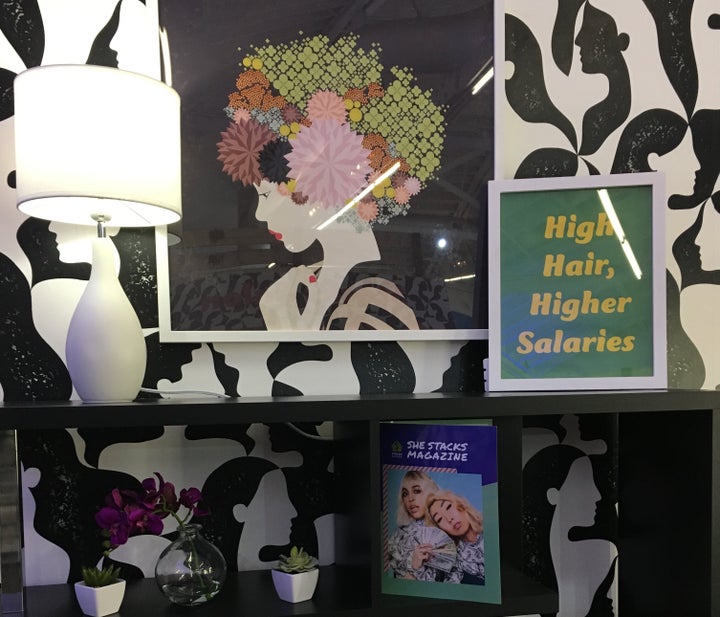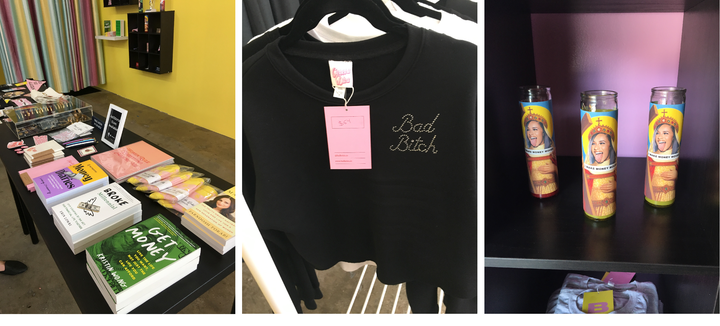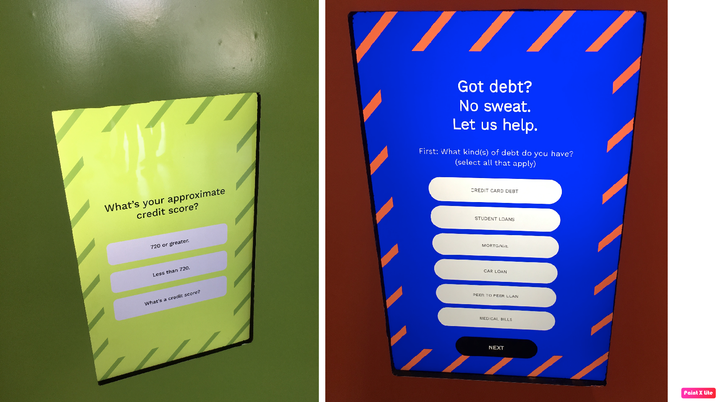
In my hometown of Los Angeles, pop-ups are as ubiquitous as Ray-Bans and Blue Bottle Coffee shops. I usually don’t give them a second thought.
But recently I noticed a new pop-up called “Stacks House” has been promoted by everyone from The New Yorker, to Refinery29, to Forbes to Time’s Money as the latest and greatest in financial literacy for women. It’s when I saw that it had been officially endorsed by Goop that I had to raise an eyebrow.
What is Stacks House and how is it actually helping women? I went there to find out ― but one hour and $38 (plus fees) later, empowered was the last thing I felt.
“Pop-Up With A Purpose”
The goal behind Stacks House, according to its website, is to promote financial independence and help close the gender wealth gap. A self-proclaimed “pop-up with a purpose,” the exhibit, which runs until May 19 in L.A. and may travel to other cities, features several money-themed rooms that are meant to instill confidence, financial literacy and inspiration in participants.
Like other pop-up museums, the space essentially serves as a giant backdrop for Instagram photos. It’s obvious the major draw of Stacks House is the opportunity to snap some bomb pics for social media. Actually learning something is secondary.
According to a news release, Stacks House is the first major initiative from She Stacks, a startup that seeks to financially empower women through an ecosystem of content, experiences and products. “We want to show women that wealth-building doesn’t have to be boring,” co-founder Kindra Meyer stated in a news release. “With She Stacks, we’re making financial literacy simple, sexy and social.”
Along with Meyer, the company is headed by Patience Ramsey and Farnoosh Torabi. Both Meyer and Ramsey describe themselves as marketing mavens, while Torabi is a personal finance author, podcaster and media personality, known for bestsellers such as “You’re So Money” and “When She Makes More.”
The installation is ironically situated on 7th Street in downtown Los Angeles, bordering the city’s notorious skid row that’s home to as many as 2,000 of the county’s approximately 50,000 homeless residents. Here in L.A., you need an annual household income of $97,160 to afford the median-priced rental home.
Inside the pop-up, the walls are painted with hollow pop culture mantras and ’Gram-worthy backdrops swathed in neons, pinks and golds. Nowhere is there #realtalk about the decades of stagnant wages workers have experienced, the dramatically rising cost of health care or the widening gap between rich and poor in our country. One display encourages attendees to commit to spending less on green juices and pricey gym membership fees. Another advises that building wealth is part math, part manifestation.
High Hair, Higher Salaries
One thing that struck me about this financial literacy-themed exhibit is that there isn’t actually any information that you can’t find by doing a quick Google search. Visitors are presented with one-off statistics that offer little context or actionable advice. For example, in the Debt Boxing Gym, where participants don boxing gloves and beat the crap out of their figurative debt, one punching bag is printed with the statistic “Student loan debt is $1.5 trillion.” A shocking number for sure, but how does the average person use that information to better their financial situation?
Surprisingly, not even the docents share financial knowledge or direct visitors to resources where they can learn more. Rather, they only seem to be there to suggest creative poses for pictures.
Like Instagram, Stacks House offers surface-level content that’s more about aesthetic than authenticity. And much of the messaging throughout the exhibit does exactly what the larger personal finance advice industry is wont to do: Boil money management down to a few basic, impersonal tips and make it seem as though your financial woes are largely a result of your faulty mindset.
Take the Money Showers, where visitors can stand in a stall and make it rain fake $100 bills while a cheery volunteer takes their picture (I will admit, it does make for a great Boomerang). On the wall, an explainer states, “Financial wellness is more than just a balanced budget. It’s having a healthy, can-do mindset. It’s about self-care and self-love.” Who knew that self-love could pay the bills?
Then there’s the Stacks Salon, where the theme is the importance of earning more money with a side hustle, since women “earn less, live longer and deal with the dreaded pink tax,” according to the placard.
There’s no mention of the fact that the pay gap disproportionately affects women of color. There’s isn’t any information about how to negotiate a higher salary (even though when we do ask, we’re less likely than men to actually get one). Instead, we’re instructed to plop down in a salon chair, snap a selfie and contemplate taking on a second job.

But nothing is quite as head-scratching as the Retirement Rodeo, which features a full-size mechanical piggy bank that participants can ride.
The tour culminates with a stop at the Stacks Shop, where visitors can buy cheeky feminist merchandise, such as clothing, pins and hats. It didn’t seem to dawn on the She Stacks team that commercializing feminist ideology, packaging it up and then selling it (at a premium) to the women who spent an hour being told their spending habits need to change is just a teensy bit hypocritical. One saving grace of the shop is that they do offer a few excellent personal finance books by some of my favorite young female writers, which I recommend buying if you’re interested in more comprehensive financial education.

Torabi confirmed that, as of now, no proceeds from ticket sales or the Stacks Shop are used to fund any financial education programs or organizations. However, she said, they are in talks about a partnership with a major nonprofit that helps women achieve economic independence.
The Financial Literacy Fallacy
The premise behind Stacks House is that the financial concerns women face today stem largely from a lack of financial literacy. If we only understood how compound interest works and why contributing to a 401(k) is important, we’d be so much better off.
Never mind that this stuff isn’t even actually explained at Stacks House. The problem is financial literacy programs don’t work. Studies show that simply sharing information with people doesn’t actually change behavior. For example, a 2014 meta-analysis of 201 existing studies found that financial education programs such as classes and one-on-one counseling have zero effect on behavior or financial health.
Why? As Get Rich Slowly blogger J.D. Roth points out, traditional financial literacy focuses only on the math and mechanics of money. The big missing piece is practical application.
Experiencing financial distress also causes people to make bad decisions, even if they know better. A 2013 study published in Science magazine found that a lack of money or time can lead to poor decision-making because the stress of the situation is so mentally exhausting.
Most of us know we need to save money. We know we need to pay off debt. But without a job that pays a living wage, or without access to resources that demystify the nuances of credit scoring and student loan repayment (or better yet, a system that doesn’t work against us in the first place), it’s much easier said than done.
Big Bank Propaganda
Clearly, there are a lot of marketing dollars backing Stacks House. What’s questionable is whom they’re ultimately benefiting.
For example, throughout the exhibit, visitors can stop at interactive kiosks that quiz their knowledge about personal finance and ask for personal details such as financial goals and credit scores. Users can then submit their emails to have educational tidbits sent to them.

Torabi assured me that the emails received by the kiosks will only be used to send the advice displayed on the kiosk at the event for easy referencing. “The data we collect at the event is otherwise anonymous, and we do not intend to use it other than in its aggregated form as a focus group for She Stacks to develop offerings that are responsive to women’s self-reported financial needs,” she said. “Any data collected through the ticket purchase process will be used in accord with Eventbrite’s privacy policy and, as with the use of all data, in compliance with all applicable policies, laws, rules and regulations.”
However, according to marketing materials obtained by HuffPost, all sponsorship packages offered by She Stacks (which range from $75,000 to $200,000 depending on the level) include “access to community member profiles/data.” After publication, Torabi told HuffPost that those figures are “the pricing breakdown regarding general demographic data,” such as age and gender, and that “if shared, will only be done anonymously.”
Speaking of sponsors, two of the sponsors behind Stacks House are major financial companies that haven’t exactly had the best track record when it comes to improving people’s financial lives. Charles Schwab, which sponsors the Retirement Rodeo, settled a lawsuit with the Securities and Exchange Commission last year over failing to file suspicious activity reports. And presenting sponsor Zelle is a person-to-person payment service owned by Early Warning Services, a private financial services company owned by Bank of America, BB&T, Capital One, JPMorgan Chase, PNC Bank, U.S. Bank and Wells Fargo. You know, the same banks that caused the financial crisis and then accepted $700 billion in government bailout money.
“Stacks House is not going to solve all the problems about financial literacy,” said Melissa Lowry, vice president of brand for Zelle. The important thing, she said, is that they’re opening the door to these conversations and getting women to feel confident.
Overall, I appreciate that the founders of Stacks House are attempting to do something new and start an important conversation. Unfortunately, the experience left me feeling confused, a bit patronized and no more educated than before I walked in.
The truth is, a conversation about wealth and women does need to happen ― with the leaders of companies who have the power to pay equal wages, with our representatives in Congress who have the power to enforce policy changes and, yes, with each other, because we have the power to call BS when we see it.
This article has been updated with a statement from Torabi about the use of data.